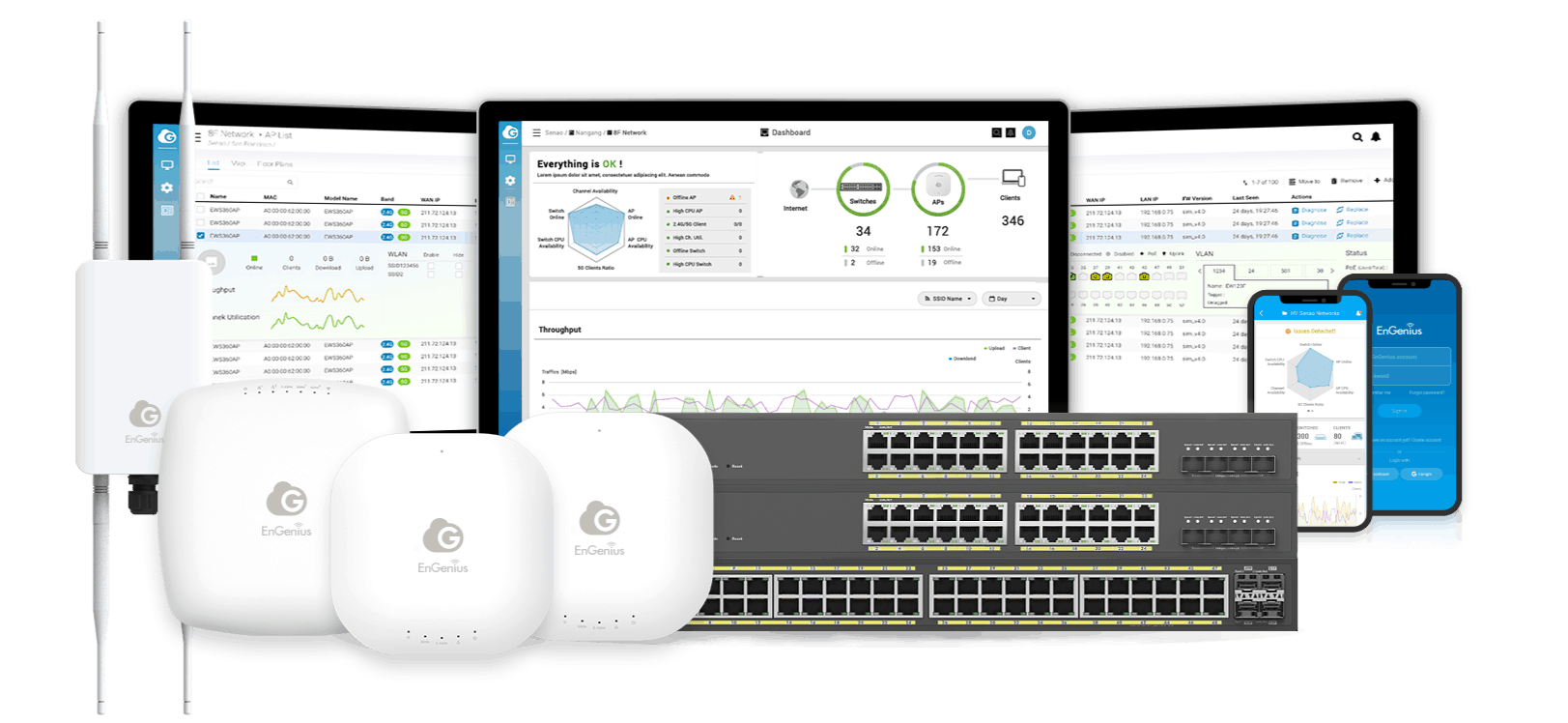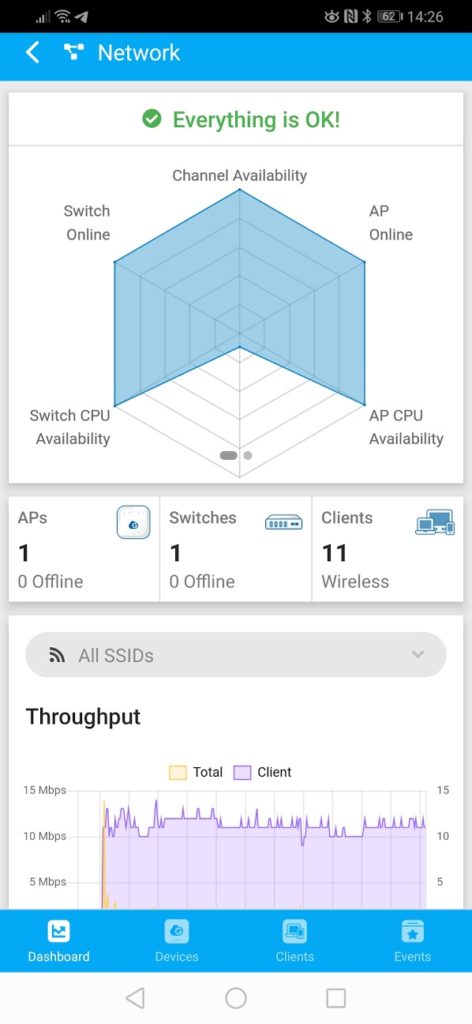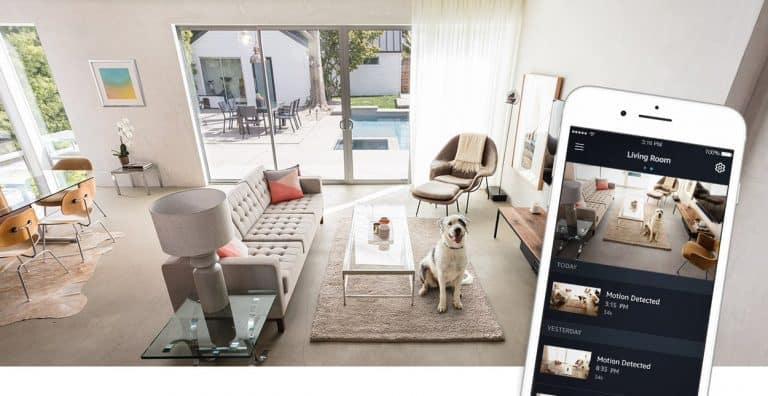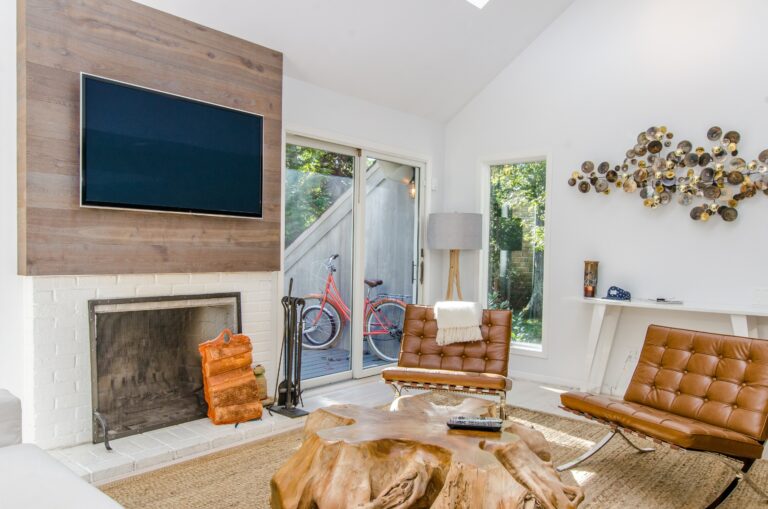Any links to online stores should be assumed to be affiliates. The company or PR agency provides all or most review samples. They have no control over my content, and I provide my honest opinion.
I have previously reviewed the EnGenius EWS357AP Dual-Band WiFi 6 PoE Access Point and then the EAP1250 access point, both of which need an Engenius SkyKey or Ezmaster server to enable the centralised cloud/LAN management.
In my review of the SkyKey, I highlighted that you could enable remote management by integrating it with the free to use EnGenius Cloud, however, the EnGenius Cloud has much more functionality than that.
Back in September, Engenius announced a new range of networking hard that was able to access the EnGenius Cloud with no additional hardware or software required, the functionality was baked right into the devices. This, therefore, allows the system to operate in a similar manner to the Zyxel Nebula range of networking gear I have been particularly fond of in the past, but this has no charge whatsoever for any of the features.
Engenius Cloud
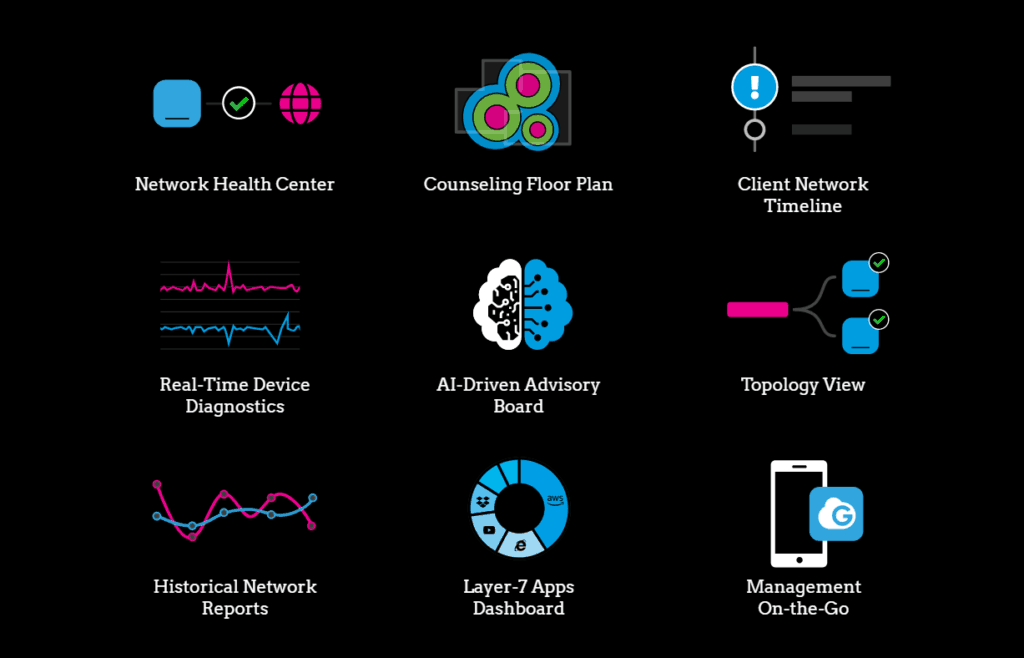
The Engenius Cloud offers much of the same functionality as the SkyKey, but in a much prettier UI, with the ability to manage multiple networks across different locations easily.
One of the selling points of the Engenius Cloud is the claimed Artificial intelligence (AI) features that predict issues before they occur and provide accurate recommendations to improve performance proactively.
So far, there is a limited range of devices compatible with it, but more than enough for most network needs. This includes five access points with a top of the range ECW230 Wi-Fi 6 access point with a multi-gig port and four spatial streams Multiple (MU)-MIMO up to 2,400 Mbps.
There are then ten switches with a mix of POE and normal, with all but my review sample including at least 2 SFP ports and all switches about the ECS1528 featuring 4 x 10G SFP+.
ECS1008P POE Switch

I was sent two cloud-enabled devices, the first a fanless POE switch with 8 ports and a 55W POE budget. At the moment, there are not many companies selling these devices and there is no Amazon stock. In the UK, the official distributor is Solwise and this will set you back £220.34. Frustratingly it is a lot cheaper in the US at around $169.00.
It has a 16Gbps switching capacity, with 32MB flash memory and 256MB SDRAM. The address database size can handle 8,000 MAC Addresses and it does all the usual things you would expect a managed POE switch to do, including:
- 802.3ad Link Aggregation
- Spanning Tree Protocol
- 802.1ab Link Layer Discovery Protocol
- IGMP Snooping
- MLD Snooping
- Jumbo Frame – up to 9,216 bytes
- 802.3x Flow Control
- VLAN / 802.1Q Support
- VLAN Group – Max 4,094 Static VLAN Groups
- Voice VLAN
- QoS
- Broadcast/Unknown Multicast/Unknown Unicast Storm Control
- Port Isolation
- DoS Attack Prevention
- BPDU Attack Prevention
- SNMP
- Cable Diagnostics
Solwise has a more thorough breakdown of the features here.
It is worth noting that this switch works with both Engenius Cloud and the SkyKey, but you can’t register it with both services at the same time (I tried).
ECW120 Access point

This also doesn’t have much availability, but you will pay £181.91 from Solwise and it seems to be available for around $159.99 in the US. It has a maximum power of 12W so you can comfortably run several of these using the above switch.
- Supercharged speeds up to 867 Mbps (5 GHz) & up to 400 Mbps (2.4 GHz)
- 2×2, Integrated Omni-directional antennas (5 dBi gain @ 2.4 GHz, 5 dBi gain @ 5 GHz)
- Power up to 23 dBm on 2.4 GHz
- Power up to 23 dBm on 5 GHz
- Wave 2 Mu-MIMO to meet Wi-Fi business demands
- Optional AP, AP mesh, and Mesh modes
- Allows more wireless clients & better connections
- Remote managing & monitoring
- Gigabit Ethernet PoE port for flexible power options
- Maximum power consumption 12W
Set up
Set-up is straightforward, you will need to sign up to Engenius Cloud, you can optionally login via social or use a normal login.
From there, you will need to set up your basic organisation and network settings. As I use this with my home office with a relatively small network, I just kept everything default.
For others, you can have multiple users with different permissions both within the organisation and the network within that organisation. Apparently you can have up to 20 hierarchical layers allowing you manage incredibly complex networks from one place.
You can have multiple organisations and multiple networks within each. So this can comfortably cater for IT companies that manage many clients, or businesses spreading across numerous locations.
With the organisation and network structure set up, you can add your inventory. I did it via the serial numbers but you can scan in the QR codes too. If you are an existing SkyKey/ezMaster user, you can import that as an item, allowing you to consolidate all your devices/networks into one place. With the inventory added you then need to assign it to your networks.
With both the switch and access point, you can make changes to the network as a whole under the configure section and then on a per device basis. So for Wi-Fi, you will set up the SSID and settings then within the device settings you can decide if you want it enabled or disabled on that device, you can also override the global radio settings. So in my case, I manually selected the radio channels and power so I could optimise it compared to the two other access points I have within the SkyKey.
Dashboard & Analytics

The UI and more importantly, the analytics have been massively improved from the SkyKey. From the dashboard, you get a quick overview of your network with it highlighting network issues for you and suggesting changes.
You get a network throughput, plus details information of your Wi-Fi network with a list of the top access points, clients, SSIDs, applications and operating systems. You can have this on day, week or month view. As a home/small business user, this doesn’t have a massive amount of use for me, but for a business looking to optimise their network, it provides a superb glance at areas to improve.
You also get network notifications via the notification icon on the top right. This tells you about config changes, device going on or offline and much more. You can have these notifications emailed to you or pushed to you via the mobile app. With emails, you can have hourly reports or per day/week. You can then customise what notifications you get sent.

Topology
This is a bit redundant for my network, but the system will build a topology overview of the network. With my network being so small, there was not much to show as it only maps out the other Engenius devices.
Clients
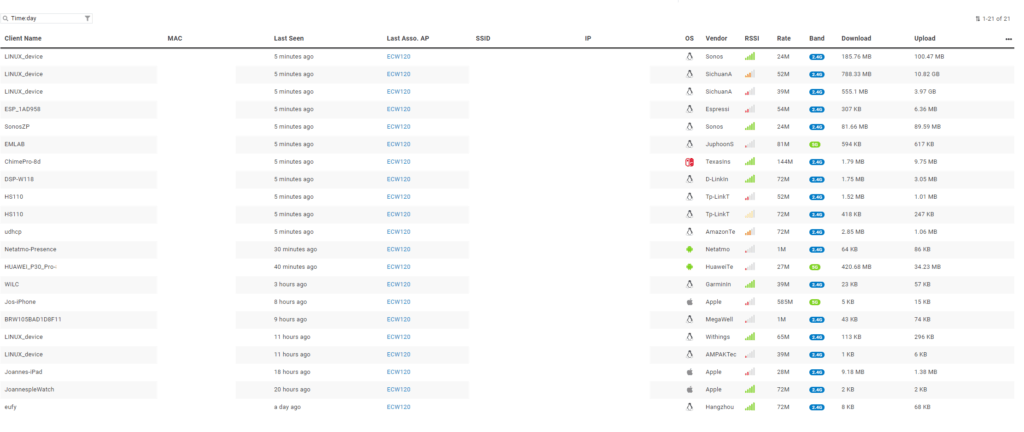
Under the clients menu, you get a more thorough breakdown of all the clients SSID they are on, the access point, RSSI, and you can also vie application details by data usage,
The RSSI data is quite useful for me, allowing me to identify areas within my home that have weak spots. If all my access points were within the system, it would be more useful as I would have a better overview.
There is no option to kick any of the clients off the network.
ECW120 & Wi-Fi settings

There are multiple sections to edit the various Wi-Fi settings. You have the SSIDs, radio settings, then the specific device settings and most of the feature replicate what you have with the SkyKey.
Within the SSID settings, you can assign a VLAN, set up traffic shaping, a captive portal plus splash page.
Even with fast roaming enabled I have noticed that I had some issues with moving between access points, and I have mostly alleviated this issue with the Force 5GHz option within the advanced settings.
Within the specific device settings, you can remove it from the common SSID and you can override the settings with a set channel and managing the transmit power levels. You can also assign a photo to it, which will likely make it easier to identify for large installations.
Within the device settings, you also get a realtime meter showing memory, CPU and throughput, so you will be able to identify possible performance problems.

Switch

In a similar manner to the Wi-Fi, you have network-wide settings but you can then override these within the switch settings itself.
Within the device page, you can view what ports are enabled, and if it is an uplink or using POE. You get feedback on your POE usage and you can assign it to static or DHCP. Within the system settings, you can override the network-wide settings.
Under the port settings, you have granular control over each port allowing yo configure its name for easy identification, speed, if POW is on or not and its priority, then assign a VLAN and more.
SkyKey
While I was able to add my SkyKey to the EnGenius Cloud, which then allowed remote management, that’s where the Cloud functionality ended. The SkyKey doesn’t feedback data to the cloud to incorporate in the analytics, so you can’t seamlessly merge the older hardware with the new cloud devices. This was to be expected but thought I should highlight it.
Mobile App
When I first downloaded the app, it wouldn’t let me log in with my Google Account, so it went unused for a while. However, this issue now seems to be resolved and the app is actually quite good.
Unlike Netgear Insight, where you manage the network from the app, this appears to be more of an informational tool. You get a lot of the analytics you find from the website, including all he usage information and any network problems. Depending on your notification settings, it will alert you as and when things come up. You can also do things like reboots and enable blinking LEDs to identify a device.
It doesn’t look like you can alter any of the important settings, including SSIDs, radio settings, or any of the settings on the switches. Personally I would prefer to do everything from a browser, but it will be interesting to see if they include these features at a later date.
Other Features
Cloud-managed networks tend to have so many features; it is inevitable I have missed a lot. If and when I find things work mentioning I will update this review here.
One thing I can’t seem to find is a backup and restore function. This is available withing the SkyKey, and it is one of the features Zyxel charge you for in their system
Overall
Engenius Cloud is a massive upgrade from the existing SkyKey and ezMaster system. For me, at least, it offers all the features I enjoyed from the Zyxel Nebula system with no subscription costs at all.
I am not so sure about the AI claims, or if they are just using buzz words. However, the data you get back from the system compared to the SkyKey has vastly be improved, and the recommendations section has been useful for tweaking the settings for me. I guess the larger the network will allow the AI features to be more intelligent.
In the UK, for now, there is quite a significant premium on these devices. The switch is currently £220 in the UK, but you can pick up the now discontinued EGS2110P from BroadBandBuyer for just £138.35 or the EWS2910P is £188 via Solwise or BroadBandBuyer.
Similarly, £181 for the access point is considerably more the EAP1250 or models from competing brands like Ubiquiti and other affordable access points.
US pricing is much more favourable, and with this system only just being launched, I would expect it to drop in price as availability becomes more widespread.
For business users, especially IT companies providing B2B solutions, the cost is likely less of an issue. Being able to manage multiple clients across many locations will likely be a huge benefit in managing the network saving a considerable amount of time and improving your response times.
If you are interested in the EnGenius Cloud then you can try the system free of charge via there demo system. This will give you an improved view of the system compared to my basic two device configuration.
Engenius Cloud with ECS1008P POE Switch & ECW120 Access point Review Rating
Summary
This is a complete overhaul of the Engenius range of hardware and a vast improvement in management features compared to the previous Engnius products that required ezMaster or SkyKey. The quality of the interface is on par with Zyxel Nebula, but this system has no fees ever.
The multi-organisation and multi-location features will no doubt be a huge selling point for businesses, especially IT companies managing other peoples networks.
Currently, pricing is a little steep if you are a home user/prosumer especially when you don’t make the most of the multi-location features.
Overall
90%-
Overall - 90%90%
I am James, a UK-based tech enthusiast and the Editor and Owner of Mighty Gadget, which I’ve proudly run since 2007. Passionate about all things technology, my expertise spans from computers and networking to mobile, wearables, and smart home devices.
As a fitness fanatic who loves running and cycling, I also have a keen interest in fitness-related technology, and I take every opportunity to cover this niche on my blog. My diverse interests allow me to bring a unique perspective to tech blogging, merging lifestyle, fitness, and the latest tech trends.
In my academic pursuits, I earned a BSc in Information Systems Design from UCLAN, before advancing my learning with a Master’s Degree in Computing. This advanced study also included Cisco CCNA accreditation, further demonstrating my commitment to understanding and staying ahead of the technology curve.
I’m proud to share that Vuelio has consistently ranked Mighty Gadget as one of the top technology blogs in the UK. With my dedication to technology and drive to share my insights, I aim to continue providing my readers with engaging and informative content.

